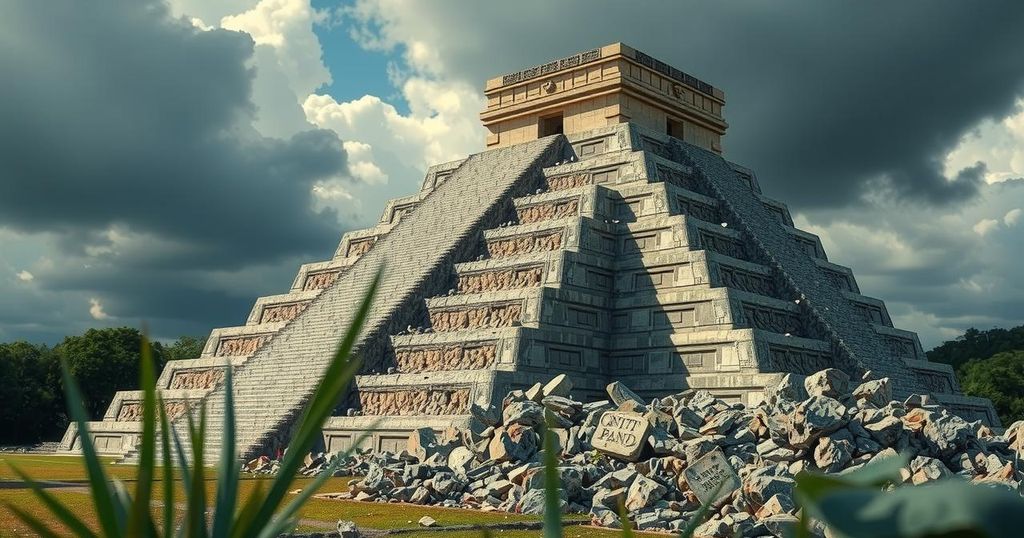Collapse of Ancient Pyramid in Mexico: A Foreboding Sign of Climate Change

In July 2024, a 15-meter-high pyramid in Michoacán, Mexico, collapsed following extreme rain and preceding drought, highlighting climate change’s threat to heritage sites. Despite being a historical treasure of the P’urhépecha culture, the structure’s damage reflects broader vulnerabilities faced by archaeological landmarks worldwide. Experts emphasize the urgent need for preservation efforts to combat these impacts.
In a troubling instance of heritage loss, a stone pyramid in Michoacán, Mexico, collapsed due to extreme weather conditions exacerbated by climate change. On July 29, 2024, heavy rainfall led to the south wall of the 15-meter-high monument crumbling into rubble. Once a notable relic of the Michoacán Kingdom civilization, this site, established over a millennium ago, suffered not only this loss but also reflects broader issues affecting archaeological sites globally. The Ihuatzio archaeological site contains multiple significant structures, including another pyramid and a fortress, all of which are crucial to understanding the region’s rich history. The pyramid in question was one of the best-preserved monuments of its kind and served as a testament to the P’urhépechas people, who successfully resisted Aztec conquest. Recent weather patterns, including the worst drought in 30 years followed by intense rainfall, have taken their toll on this cultural landmark. Nevertheless, only one pyramid sustained visible damage, though officials from the National Institute of Anthropology and History (INAH) indicate that several others also exhibit signs of deterioration due to these climatic shifts. Extreme weather and rising sea levels, both linked to human-induced climate change, pose considerable risks to culturally significant sites worldwide. For example, recent studies have highlighted the deterioration of ancient cave paintings in Oceania, as well as threats to various heritage materials across Europe and Mexico, further illustrating the pervasive impact of climate change on archaeological integrity. As noted by INAH, “The high temperatures, previously recorded in the area, and the consequent drought caused cracks that favored the filtration of water into the interior of the pre-Hispanic building.” This sequence of events made the collapse inevitable and underscores the urgent need for structural repairs to preserve these irreplaceable sites. Tariakuiri Alvarez, a descendant of the P’urhépecha tribe, expressed a cultural perspective on the collapse, interpreting it as a “bad omen”—a sentiment that echoes historical concerns regarding disruptions to sacred environments. Alvarez stated, “Before the arrival of foreign conquerors in Mexico, something similar happened, and it was because the gods were ‘displeased’.” This incident is emblematic of the broader threats faced by heritage sites worldwide, including Utah’s Double Arch, which also succumbed to changing environmental conditions shortly before the pyramid’s collapse. The ongoing degradation of these important sites serves as a stark reminder of the long-term consequences of climate change. As we witness the dismantling of our historical legacies, it is imperative to recognize the need for preservation and proactive measures to secure these treasures for future generations. Efforts to repair and maintain these structures not only honor cultural heritage but also foster a dialogue about humanity’s responsibility toward the historical narratives that shape our understanding of the past. In summary, climate change poses a substantial threat to archaeological sites, necessitating urgent attention to both their preservation and the broader environmental issues at play. An earlier version of this article was published in August 2024.
The preservation of cultural heritage sites is increasingly jeopardized by climate change, exemplified by the recent collapse of a pyramid in Mexico. Such incidents illustrate a pressing global concern as rising temperatures and extreme weather patterns threaten ancient landmarks, often leading to irreparable damage. Historical sites like the one in Michoacán are not only crucial to understanding human history but also require urgent protection against the adverse effects of climate disruption. The broader implications extend beyond a single site, as multiple heritage structures face similar vulnerabilities worldwide across varying climates and geographies.
In conclusion, the collapse of the pyramid in Michoacán highlights the significant impact of climate change on archaeological sites and calls for immediate action to protect cultural heritage. The intertwining of environmental changes and cultural preservation necessitates a concerted effort from governments, communities, and conservationists alike to address these urgent threats. As we contend with the reality of a changing climate, it becomes increasingly clear that safeguarding our history is as critical as preserving the environment for future generations.
Original Source: www.sciencealert.com







